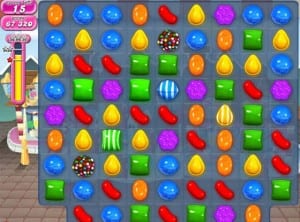"If you build it, they will come."
It's a magical phrase. One which, unfortunately, only works in the movies. In real life, building a website takes time and effort, and bringing prospects to that website takes even more time and effort.
For those businesses that need some extra income right away, AdWords advertising might be just the solution they are looking for.
You might hear several terms associated with this type of advertising. PPC (pay per click), SEM (search engine marketing), paid search, and AdWords are all essentially the same thing. AdWords is the name of the Google product that lets you create and manage pay-per-click ads on the Google search engine.
These ads typically appear at the top and bottom of search results. They used to be seen on the right side as well, but recent changes to Google have removed the right side ads. You can know which results are ads by the small yellow box that says "AD."

The idea is that you choose some keywords that people might search when they are looking for what you sell. You'll be competing with other advertisers using the same keywords, so you'll have to decide what you are willing to pay for these ads, and experiment to make your ads as appealing as possible.
Having your ad seen costs you nothing with PPC, you only pay when someone clicks on your ad. The cost of this click is referred to as the cost-per-click, or CPC. (Some types of ads charge by the impression rather than the click, but more on that later.)
AdWords advertising has some clear advantages for most businesses, but it is not for everyone. Some reasons you might want to avoid this type of advertising include:
On the other hand, AdWords can be extremely effective, when done right.
One of the reasons AdWords advertising works so well is that a good chunk of people (around 40%, in fact) do not realize they are looking at ads, and cannot differentiate between paid and organic search results.
 If you've ever played Candy Crush on your phone, you'll understand the importance of keeping your goals in mind.
If you've ever played Candy Crush on your phone, you'll understand the importance of keeping your goals in mind.
This game uses lots of special candies which have all kinds of fun capabilities. But if you're not careful, you'll get so caught up creating and using those striped or sprinkle candies, you'll forget all about your goal.
AdWords has plenty of fun capabilities too. It's easy to get caught up trying to use a lot of fancy functionality, and forget to accomplish your goals. We always recommend you set your goals FIRST, and let those guide your advertising choices.
As with everything in life, a smart strategy can make all the difference. It's easy to waste your AdWords budget if your ads are not setup to convert. Creating and maintaining efficient campaigns takes practice. Advertising should be structured to make every dollar count.
When we work with business owners on their AdWords campaigns, we always recommend the following actions.

Retargeting, also called remarketing, can be an extremely effective tool. Have you ever searched for a product on Amazon, then gone to a different website, only to see ads everywhere for the Amazon product you were just searching? This is retargeting.
Imagine that you have a brick-and-mortar store, and you try as hard as you can to collect customers addresses, so you can thank them for coming, and mail them coupons periodically. This type of marketing turns one-time customers into repeat customers. Your mailers remind them about the store, and the coupons and sales ads give them a good excuse to come back.
But if your store is a website, how can you accomplish the same goal?
Retargeting is a type of advertising that helps you do just that. A small piece of code is added to your website that tracks people who have visited the site. You can incorporate this code into your AdWords ads, and it gives AdWords the ability to show certain ads to people who have already visited your website. It gives you the opportunity to offer them coupons, show them similar products to those they have already viewed, or give them a good excuse to come back.
Retargeting is also ideal for industries in which conversions often take time. Some larger purchases, or B2B projects, require research and collaboration before purchase. In these cases, keeping your company name in the memory of your prospects can make a big difference to your bottom line.

Just as with other types of PPC ads, it's important to have goals for your retargeting ads. Some common goals might be:
It's also important to understand what retargeting won't do. Retargeting probably won't bring in the same amount of traffic that regular PPC ads do. You'll probably see fewer one-per-click conversions. And, it can be tough to measure because with repeat customers, your ads will bring your brand to their memory, but clicking the ads may not be the method they use to navigate back to your site.
Once you have clearly identified your goals, it's important to decide how you're going to measure your progress.
Remember that measurement has its limitations, too.
Sometimes a customer might find your website through an ad, then leave, bookmark the site, or remember the name. When they come back a second time, it may not look like they have found you from the ads, even though it was their initial point of contact.
Google is working to provide advertisers with more specific demographic information, but unlike Facebook, many Google users are not signed in when they are searching. This makes it difficult for Google to advertise to people based on age, income, gender, career, or anything else.
This is why we focus on keywords. It filters users based on intent.
After all, finding people who are searching for what you provide is the ultimate demographic.
We can't really discuss ads without touching on display ads.

Rather than focusing on words, display ads are images. They appear on all kinds of websites. Lots of websites run display ads, because they can make some income from them. They come in several different sizes, so it's a good idea to have images designed in the most common sizes, at least.
Display ads typically do not convert well. They have lower click-through rates than other types of ads. However, they do have one very distinct advantage, and that is the ability to show users what your product looks like, or make a clear emotional connection to your brand in a visual way.
This is particularly helpful if you are trying to establish a new brand, or launch a new product line. They also work well when paired with remarketing efforts.

Whatever option works best for your business, ongoing ad management and optimization is a big job. It's a good idea to consider hiring an expert to manage your ads. Here at Be Locally SEO, we are Google AdWords partners, which means we are fully qualified to create and manage business ads, and we do it well.
Contact us today for a consultation about your advertising or Utah SEO needs.
